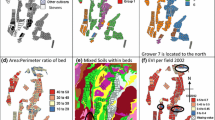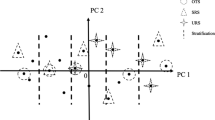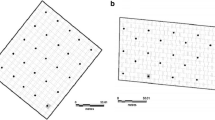Abstract
Cranberry harvesting methods give only one yield value per field making characterization of within-field variation, the usual first step in precision farming, difficult. Time-consuming berry count yield and fruit rot estimations are the best “ground truth” indication of yield variation within fields. Correlations and coincidence of binary classifications based on less expensive methods such as enhanced vegetation index (EVI) from imagery, and area to point (AtoP) kriging of useable, poor quality and trash yields were compared with this “ground truth”. In general AtoP kriged values gave higher correlations and kappa statistic values with berry counts and fruit rot than EVI. Geostatistical disaggregation of per field yield totals using AtoP kriging with EVI as an external drift (AtoPKED) was also investigated. Factorial kriging was used to separate the several scales of variation in “ground truth” and EVI data and determine which ones were most spatially coherent/manageable and which related best to the AtoP kriged data. The spatial trend component of pre-harvest berry counts and AtoP kriging of yields both gave a good initial definition of spatially coherent, relatively permanent management zones. They were related to topography and depth of water table in the soil which are key factors governing cranberry yield. AtoP kriging or AtoPKED are recommended for defining management zones as they are less expensive than berry counts. The value of AtoP kriging to precision farmers for other crops to map soils at the farm scale with some imagery and just one bulked soil sample per field or use nutrient levels associated with each polygon of traditional soil survey maps is discussed in the conclusions.








Similar content being viewed by others
References
Acevedo-Opazo, C., Tisseyre, B., Guillaume, S., & Ojeda, H. (2008). The potential of high spatial resolution information to define within-vineyard zones related to vine water status. Precision Agriculture, 9, 285–302.
Adamchuk, V. I., Hummel, J. W., Morgan, M. T., & Upadhyaya, S. K. (2004). On-the-go soil sensors for precision agriculture. Computers and Electronics in Agriculture, 44, 171–191.
Auernhammer, H., Demmel, M., Muhr, T., Rottmeier. J., & Wild, K. (1993). Yield measurements on combine harvesters. American Society of Agricultural Engineers Paper No. 93-1506.
Bain, H. F. (1946). Blooming and fruiting habits of the cranberry in Wisconsin. Cranberries, 10, 11–14.
Baluja, J., Diago, M. P., Goovaerts, P., & Tardaguila, J. (2012). Assessment of the spatial variability of grape anthocyanins using a fluorescence sensor. Relationships with vine vigour and yield. Precision Agriculture, 13, 457–472.
Bergman, H. F. (1950). Cranberry flower and fruit production in Massachusetts. Cranberries, 15, 6–10.
Birrell, S. J., Borgelt, S. C., & Sudduth, K. A. (1995). Crop yield mapping: Comparison of yield monitors and mapping techniques. In P.C. Robert, R.H. Rust, & W.E. Larson (Eds.), Site-specific management for agricultural systems. Proceedings of the 2nd international conference, Minneapolis, Minnesota (pp. 15–32). Madison, WI: American Society of Agronomy, Crop Science Society of America, Soil Science Society of America.
Birrenkott, B. A., & Stang, E. J. (1990). Selective flower removal increases cranberry fruit set. HortScience, 25, 1226–1228.
Bramley, R. G. V., & Lamb, D. W. (2003). Making sense of vineyard variability in Australia. In R. Ortega & C. Esser (Eds.), Proceedings of the international symposium on precision viticulture, 9th Latin American congress on viticulture and oenology (pp. 35–54). Santiago, Chile.
Cohen, J. (1960). A coefficient of agreement for nominal scales. Educational and Psychological Measurement, 20, 37–46.
Cook, S. E., & Bramley, R. G. V. (1998). Precision agriculture—Opportunities, benefits and pitfalls of site-specific crop management in Australia. Australian Journal of Experimental Agriculture, 38, 753–763.
Da Costa, J. P., Michelet, F., Germain, C., Lavialle, O., & Grenier, G. (2007). Delineation of vine parcels by segmentation of high resolution remote sensed images. Precision Agriculture, 8, 95–110.
DeMoranville, C., Roper, T., & Davenport, J. (2007). Determining the correct phosphorus rate for productive cranberries. HortScience, 42, 896–897.
Goovaerts, P. (2008). Kriging and semivariogram deconvolution in the presence of irregular geographical units. Mathematical Geosciences, 40, 101–128.
Grenzdörffer, G., & Gebbers, R. I. B. (2001). Seven years of yield mapping—Analysis and possibilities of multi-year yield mapping data. In G. Grenier & S. Blackmore (Eds.), ECPA 2001 (pp. 31–36). Montpellier, France: Agro-Montpellier.
Hagidimitriou, M., & Roper, T. (1994). Seasonal changes in non-structural carbohydrates in cranberry. Journal of the American Horticultural Science, 119, 1029–1033.
Huete, A., Didan, K., Miura, T., Rodriguez, E. P., Gao, X., & Ferreira, L. G. (2002). Overview of the radiometric and biophysical performance of the MODIS vegetation indices. Remote Sensing of Environment, 83, 195–213.
Johnson, L., Lobitz, B., Bosch, D., Wiechers, S., Williams, D., & Skinner, P. (2000). Of pixels and palates: Can geospatial technologies help produce a better wine? In Second international conference in spatial information in agriculture and forestry, Lake Buena Vista, FL, January 10–12 (Vol. 1, pp. 105–106). Ann Arbor, MI: ERIM International Inc.
Kerry, R., Giménez, D., Oudemans, P., & Goovaerts, P. (2010). Investigating the potential of area-to-point kriging for defining management zones for precision farming of cranberries. In P. M. Atkinson & C. D. Lloyd (Eds.), GeoENV 2008—Geostatistics for environmental applications (pp. 265–278). London: Springer.
Kerry, R., Goovaerts, P., Gimenez, D., & Oudemans, P. V. (submitted). Exploring temporal and spatial patterns in yield of cranberries in New Jersey for precision farming.
Kerry, R., Goovaerts, P., Rawlins, B. G., & Marchant, B. P. (2012). Disaggregation of legacy soil data using area to point kriging for mapping soil organic carbon at the regional scale. Geoderma, 170, 347–358.
Khosla, R., Inman, D., Westfall, D. G., Reich, R. M., Frasier, M., Mzuku, M., et al. (2008). A synthesis of multi-disciplinary research in precision agriculture: Site-specific management zones in the semi-arid western Great Plains of the USA. Precision Agriculture, 9, 85–100.
Kyriakidis, P. (2004). A geostatistical framework for area-to-point spatial interpolation. Geographical Analysis, 36, 259–289.
Laederach, P., Oberthuer, T., & Cook, S. (2011). Systematic agronomic farm management for improved coffee quality. Field Crops Research, 120, 321–329.
Landis, J. R., & Koch, G. G. (1977). The measurement of observer agreement for categorical data. Biometrics, 33, 159–174.
Lark, R. M., & Stafford, J. V. (1996). Classification as a first step in the interpretation of temporal and spatial variability of crop yield. Modelling in Applied Biology: Spatial Aspects., 46, 139–142.
Martinez-Casasnovas, J. A., Agelet-Fernandez, J., & Arno, J. (2012). Analysis of vineyard differential management zones and relation to vine development, grape maturity and quality. Spanish Journal of Agricultural Research, 10, 326–337.
Marucci, P. E. (1966). Cranberry pollination. Cranberries, 30, 11–13.
Morari, F., Castrignano, A., & Pagliarin, C. (2009). Application of multivariate geostatistics in delineating management zones within a gravelly vineyard using geo-electrical sensors. Computers and Electronics in Agriculture, 68, 97–107.
Novy, R. G., Vorsa, N., & Patten, K. (1996). Identifying genotypic heterogeneity in ‘McFarlin’ cranberry: A randomly-amplifies polymorphic DNA (RAPD) and phenotypic analysis. Journal of the American Society of Horticultural Science, 121, 210–215.
Oliver, M. A. & Carroll, Z. L. (2004). Description of spatial variation in soil to optimize cereal management. Project Report No. 330. London: HGCA.
Oliver, M. A., Webster, R., & Slocum, K. (2000). Filtering SPOT imagery by kriging analysis. International Journal of Remote Sensing, 21, 735–752.
Oudemans, P. V., Polashock, J. L., & Vinyard, B. T. (2008). Fairy ring disease of cranberry: Assessment of crop losses and impact on cultivar genotype. Plant Disease, 92, 616–622.
Oudemans, P. V., Pozdnyakova, L., Hughes, M. G., & Rahman, F. (2002). GIS and remote sensing for detecting yield loss in cranberry culture. Journal of Nematology, 34, 207–212.
Paoli, J. N., Tisseyre, B., Strauss, O., & McBratney, A. B. (2010). A technical Opportunity index based on the fuzzy footprint of a machine for site-specific management: Application to viticulture. Precision Agriculture, 11, 379–396.
Patten, K. D., & Wang, J. (1994). Cranberry yield and fruit quality reduction caused by weed competition. HortScience, 29, 1127–1130.
Payne, R. W. (Ed.). (2006). The guide to GenStat release 9—Part 2: Statistics (p. 319). Hemel Hempstead, UK: VSN International.
Pozdnyakova, L., Giménez, D., & Oudemans, P. V. (2005). Spatial analysis of cranberry yield at three scales. Agronomy Journal, 97, 29–57.
Pozdnyakova, L., Oudemans, P. V., Hughes, M. G., & Giménez, D. (2002). Estimation of spatial and spectral properties of phytophthora root rot and its effects on cranberry yield. Computers and Electronics in Agriculture, 37, 57–70.
Pringle, M. J., McBratney, A. B., Whelan, B. M., & Taylor, J. A. (2003). A preliminary approach to assessing the opportunity for site-specific crop management in a field using yield monitor data. Agricultural Systems, 76, 273–292.
IBM Corp. Released 2011. IBM SPSS statistics for windows, Version 20.0. Armonk, NY: IBM Corp.
Roudier, P., Tisseyre, B., Poilvé, H., & Roger, J. (2011). A technical opportunity index adapted to zone-specific management. Precision Agriculture, 12, 130–145.
Soil Survey Staff, Natural Resources Conservation Service, United States Department of Agriculture. Soil Survey Geographic (SSURGO) Database for Burlington County, New Jersey. Retrieved December, 2009 from http://soildatamart.nrcs.usda.gov.
Strik, B. C., Roper, T. R., Demoranville, C. J., Davenport, J. R., & Poole, A. P. (1991). Cultivar and growing region influence return bloom in cranberry uprights. HortScience, 26, 1366–1367.
Taylor, J. A., Coulouma, G., Lagacherie, P., & Tisseyre, B. (2009). Mapping units within a vineyard using statistics associated with high-resolution apparent soil electrical conductivity data and factorial discriminant analysis. Geoderma, 153, 278–284.
Taylor, J. A., McBratney, A. B., & Whelan, B. M. (2007). Establishing management classes for broadacre agricultural production. Agronomy Journal, 99, 1366–1376.
Tisseyre, B., Mazzoni, C., Ardoin, N., & Clipet, C. (2001). Yield and harvest quality measurement in precision viticulture—Application for a selective vintage. In G. Grenier & S. Blackmore (Eds.), ECPA 2001. Proceedings of the 3rd European conference on precision agriculture, Montpellier, France (pp. 133–138). Montpellier, France: Agro-Montpellier.
Tisseyre, B., & McBratney, A. B. (2008). A technical opportunity index based on mathematical morphology for site-specific management: An application to viticulture. Precision Agriculture, 9, 101–113.
Viscarra Rossel, R. A., & McBratney, A. B. (1998). Laboratory evaluation of a proximal sensing technique for simultaneous measurement of soil clay and water content. Geoderma, 85, 19–39.
Viscarra Rossel, R. A., Walvoort, D. J. J., McBratney, A. B., Janik, L. J., & Skjemstad, J. O. (2006). Visible, near infrared, mid infrared or combined diffuse reflectance spectroscopy for simultaneous assessment of various soil properties. Geoderma, 131, 59–75.
Vitharana, U. W. A., Van Meirvenne, M., Simpson, D., Cockx, L., & De Baerdemaeker, J. (2008). Key soil and topographic properties to delineate potential management classes for precision agriculture in the European loess area. Geoderma, 143, 206–215.
Acknowledgments
We are grateful for the reviewer’s comments which helped improved this paper markedly. Ocean Spray Cranberries Inc. provided yield data. Funding was provided as part of USDA-IFAFS Grant # 2001-52103-11310. Larisa Pozdnyakova Golovko of RiceTec, Alvin, TX, collected and pre-processed data. Dan A. Sims, Ball State University, calculated EVI values and Richard Shaw USDA-Natural Resources Conservation Service, Somerset, NJ conducted the GPR field surveys. Dr. Goovaerts’ work was funded by Grant 1R21 ES021570-01A1 from the National Cancer Institute. The views stated in this publication are those of the authors and do not necessarily represent the official views of the NCI.
Author information
Authors and Affiliations
Corresponding author
Rights and permissions
About this article
Cite this article
Kerry, R., Goovaerts, P., Giménez, D. et al. Investigating geostatistical methods to model within-field yield variability of cranberries for potential management zones. Precision Agric 17, 247–273 (2016). https://doi.org/10.1007/s11119-015-9408-7
Published:
Issue Date:
DOI: https://doi.org/10.1007/s11119-015-9408-7




